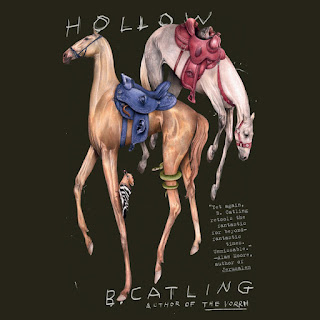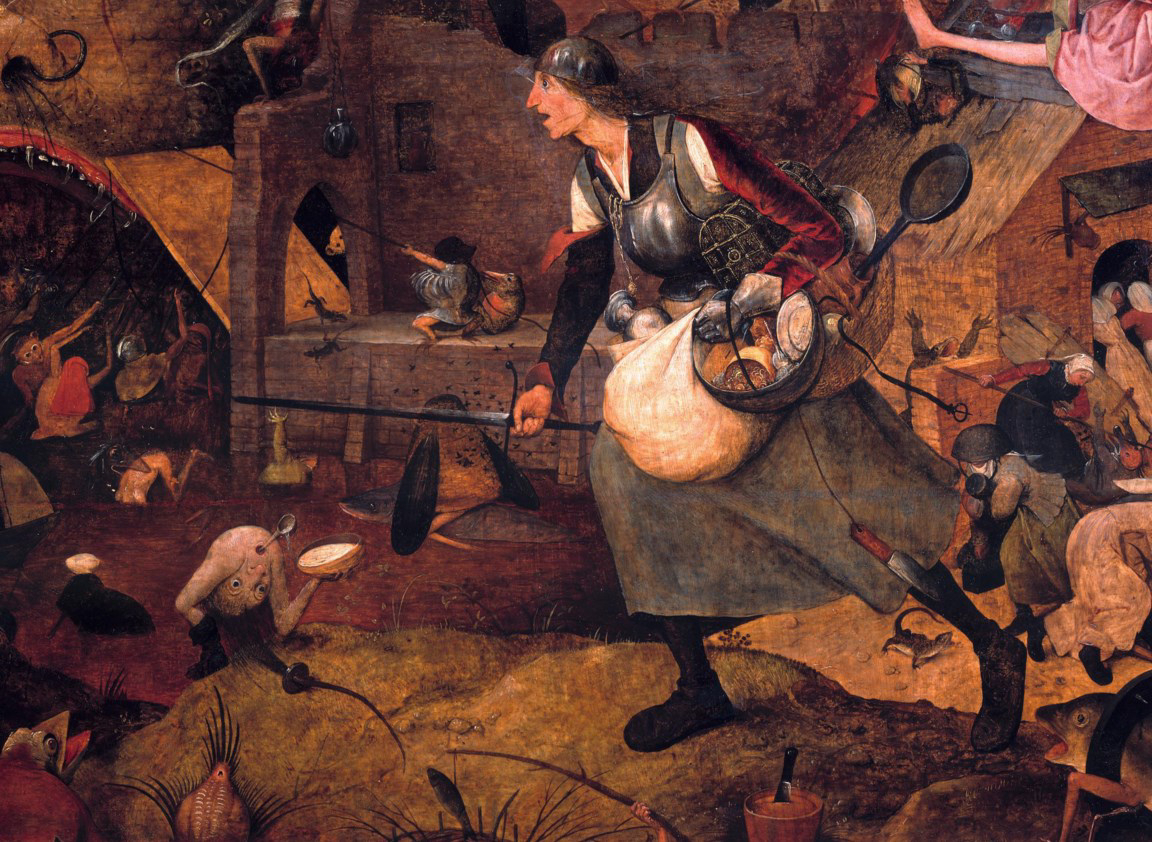In his stand-alone novel Hollow his background in the visual arts is one again very much on display, but this time instead of an impression of Eden in Africa, he's chosen to invent a story for which the paintings of Pieter Breugel the Elder and Hieronymus Bosch might serve as illustrations - or, say, he's written back stories for the beings that populate those images.
It's even cooler than it sounds. Which is mighty good, incidentally; narrator Jonathan Keeber is very much in the vein of Allan Corduner, or Simon Vance or John Lee, but doesn't quite hit their very high mark, mainly due to his tendency to make too many of the novel's inhuman or demihuman characters, and one monk with a sligt speech impediment, sound like Gollum with a bunch of juicy sweet fish in his mouth. I had to listen to those bits of dialogue multiple times to parse out what was being said, which is troublesome indeed when one such character is the very oracle whose utterings feel very much like the key to the story. Mercifully, there is not a lot of this in the book, and Keeber's reading of it is otherwise exceptional.
But so, what's Hollow all about then?
The action this time is set in Europe and concerns a motley D&D gang of murder hobos on a mission to deliver an Oracle to a weird monastery that may have been built on the ruins of the Tower of Babel.* Said Oracle is small and greyish in color, with atrophied limbs and unsettling aspect -- and, as the murder hobos discover to their cost, has an unsettling talent for ventriloquism, used to disturbing and deadly effect on a few occasions during their journey.
I could not help but imagine this Oracle and the one it's to replace as something like good old Dalek Caan from Doctor Who, also a weird and atrophied thing with weird prophetic powers and a creepy voice. Your mileage may vary.
Anyway, while the murder hobos escort this Oracle, two brothers from the monastery that is their destination embark on a journey of their own, to find out the source of some weird creatures that have been turning up in their neighborhood.
Interwoven with the tales of these journeys are some bizarre and creepy goings-on at the monastery, and also the account of how one of my favorite characters in western painting, Dulle Griet, aka Mad Meg, evolves from a humble and much-abused wife and mother, living in the village that supports the weird monastery, into the avenging proto-feminist virago that Bruegel immortalized as leading a band of women to attack Hell. In Catling's account of this evolution, she has a best friend who gets burned as a witch, a dumb failson, and a worthless and abusive husband, so it is with relied that we watch as she befriends all of the strange creatures who share the Bruegel canvas with her, further endearing her to me. I loved Mad Meg long before I read this book, but this book made me love her even more.
As for the Oracle, as I said, it is an ill-defined creature (possibly related to the Erstwhile of the Vorrh?) whose natural habitat is a tightly enclosed place. The first of its kind (for there are more than one) that we meet has been walled up in the monastery, where a small community of monks devotedly study its weird and gnomic emanations until, under suspicious circumstances, it disappears and dies. Or does it? At any rate, another is sent for, hence the escort mission, but meanwhile the original may be haunting the place, sort of? Anyway, weird things start happening but they don't seem quite as weird as they are against the backdrop of this monastery, which contains a walled-off battlefield of some five square miles in which the zombie-ish dead and the tormented living engage in perpetual warfare against one another.
Meg, on the other hand, has mostly mundane problems to deal with, until suddenly she, too, encounters the "Woebegot" aka "Filthlings" - bizarre little creatures with human and animal characteristics turning up all over the place and annoying those they don't just outright frighten. They are, of course, figures from Bruegel and Bosch, and when they start talking to Meg in their confused polyglot way it is impossible not to imagine them as Monty Python-esque animations. Eventually they become, as I said, something like friends to Meg and become along with her my favorite figures in the story, at times intensely comic (such as the account of how three of them came to be named Bleagh, Garrett and Eueuw, whom Meg accidentally "summons" when an unrelated incident causes her to make these noises!), at others uncanny and disturbing. What do they even want? What can they even do?
We're mostly supposed to care about the escort mission, though, and it is also bizarrely entertaining as the mercenaries are picked off one by one (one of them is killed off right at the beginning of the first chapter by the party's leader for reasons that seem arbitrary and disproportionate for a long time until they're sort of explained) and encounter strange things like a menacing but ultimately helpful giant in their travels with their strange dependant. Whom they must feed every night. By taking turns confessing their worst sins into a bag of bones. So that their confessions enrich the marrow. Which is then fed by spoonfuls, like so much baby food, to the Oracle.
I love Brian Catling.
So much.
The mechanism by which the murder hobos must feed the Oracle gives us a chance to get to know them at a satisfying and deep level as they dredge up their most horrific personal anecdotes, like one man who was used by a bunch of nuns as angel bait and later winds up eating said angel (he can't compare it to chicken nuggets though, since those are hundreds of years in the future).
All of these narrative threads come together in the end just in time for Fat Tuesday, celebrated in proper batshit fashion in Meg's village, in bizarre and bloody fashion, with some highly entertaining violence, some grotesque comeuppance, and the entry of at least one character into perhaps the worst kind of eternity that doesn't actually involve devils and pitchforks and lakes of fire. The ending chapters especially reward close attention, as characters keep appearing from weird perspectives as their storylines intersect and the Woebegots finally fulfill what I guess is their purpose? But maybe it's just a side benefit of fulfilling their true purpose?
I'm going to have to read this one again sometime soon. What hardship!
*Which, that tower sure has been turning up in a lot of my reading lately.



Wonderful review, I have just finished “Hollow” . Brian was a dear old friend of mine, you did him proud.
ReplyDeleteThat's very kind of you to say. I wish I could have met him. He seems like he was definitely my kind of guy. The more I learn about him, the more he inspires me!
Delete